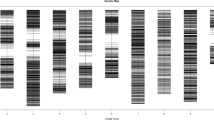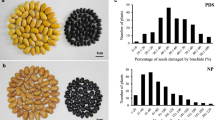Abstract
The Asian Vigna group of grain legumes consists of six domesticated species, among them black gram is widely grown in South Asia and to a lesser extent in Southeast Asia. We report the first genetic linkage map of black gram [Vigna mungo (L.) Hepper], constructed using a BC1F1 population consisting of 180 individuals. The BC1F1 population was analyzed in 61 SSR primer pairs, 56 RFLP probes, 27 AFLP loci and 1 morphological marker. About 148 marker loci could be assigned to the 11 linkage groups, which correspond to the haploid chromosome number of black gram. The linkage groups cover a total of 783 cM of the black gram genome. The number of markers per linkage group ranges from 6 to 23. The average distance between adjacent markers varied from 3.5 to 9.3 cM. The results of comparative genome mapping between black gram and azuki bean show that the linkage order of markers is highly conserved. However, inversions, insertions, deletions/duplications and a translocation were detected between the black gram and azuki bean linkage maps. The marker order on parts of linkage groups 1, 2 and 5 is reversed between the two species. One region on black gram linkage group 10 appears to correspond to part of azuki bean linkage group 1. The present study suggests that the azuki bean SSR markers can be widely used for Asian Vigna species and the black gram genetic linkage map will assist in improvement of this crop.


Similar content being viewed by others
References
Blair MW, Pedraza F, Buendia HF, Gaitán-Soltís E, Beebe SE, Gepts P, Tohme J (2003) Development of genome-wide anchored microsatellite map for common bean (Phaseolus vulgaris L.). Theor Appl Genet 107:1362–1374
Boutin SR, Young ND, Olson TC, Yu ZH, Shoemaker RC, Vallejos CE (1995) Genome conservation among three legume genera detected with DNA markers. Genome 38:928–937
Chinchest A, Nakeerak P (1990) Mutation breeding on blackgram (Vigna mungo). In: Proceedings of the Mungbean meeting 90. Tropical Agriculture Research Center, Japan, pp 35–36
Choi HK, Mun JH, Kim DJ, Zhu H, Baek JM, Mudge J, Roe B, Ellis N, Doyle J, Kiss GB, Young ND, Cook DR (2004) Estimating genome conservation between crop and model legume species. PNAS 101:15289–15294
Doi K, Kaga A, Tomooka N, Vaughan DA (2002) Molecular phylogeny of genus Vigna subgenus Ceratotropis based on rDNA ITS and atpB-rbcL intergenic spacer of cpDNA sequences. Genetica 114:129–145
Draper J, Scott R (1988) The isolation of plants nucleic acids. In: Draper J, Scott R, Armitage P, Walden R (eds) Plant genetic transformation and gene expression, Blackwell, London, pp 212–214
Duke JA (1981) Handbook of legumes of world economic importance. Plenum Press, New York
Fatokun CA, Menancio-Hautea DI, Danesh D, Young ND (1992) Evidence for orthologous seed weight genes in cowpea and mungbean based on RFLP mapping. Genetics 132:6–13
Fuller DQ (2002) Fifty years of archaeological studies in India: laying a solid foundation. In: Settar S, Korisettar R (eds) India archaeology in retrospect, vol. III. Archaeology and interactive disciplines. Indian Council of Historical Research, Manohar, pp 247–364
Gaitán-Soltís E, Duque MC, Edwards KJ, Tohme J (2002) Microsatellite repeats in common bean (Phaseolus vulgaris L.): isolation, characterization, and cross-species amplification in Phaseolus spp. Crop Sci 42:2128–2136
Han OK, Kaga A, Isemura T, Wang XW, Tomooka N, Vaughan DA (2005) A genetic linkage map for azuki bean [Vigna angularis (Willd.) Ohwi & Ohashi]. Theor Appl Genet 111:1288–1299
Humphry ME, Konduri V, Lambrides CJ, Magner T, McIntyre CL, Aitken EAB, Liu CJ (2002) Development of a mungbean (Vigna radiata) RFLP linkage map and its comparison with lablab (Lablab purpureus) reveals a high level of colinearity between the two genomes. Theor Appl Genet 105:160–166
Kaga A, Tomooka N, Egawa Y, Hosaka K, Kamijima O (1996) Species relationships in the subgenus Ceratotropis (genus Vigna) as revealed by RAPD analysis. Euphytica 88:17–24
Kaga A, Ishii T, Tsukimoto K, Tokoro E (2000) Comparative molecular mapping in Ceratotropis species using and interspecific cross between azuki bean (Vigna angularis) and rice bean (V. umbellata). Theor Appl Genet 100:207–213
Kaga A, Vaughan DA, Tomooka N (2005) Molecular markers in Vigna improvement: understanding and using gene pools. In: Lorz H, Wenzel G (eds) Biotechnology in Agriculture and Forestry, vol 55. Molecular marker systems. Springer, Berlin Heidelberg New York, pp 171–187
Kosambi DD (1944) The estimate of map distances from recombination value. Ann Eugen 12:172–175
Li CD, Fatokun CA, Ubi B, Singh BB, Scoles GJ (2001) Determining genetic similarities and relationships among cowpea breeding lines and cultivars by microsatellite markers. Crop Sci 41:189–197
Luloki L, Maréchal R, Otoul E (1980) Les ancêstres sauvages des haricots cultivés: Vigna radiata (L.) Wilczek et V. mungo (L.) Hepper. Bull Jard Bot Belg 50:385–391
Maughan PJ, Saghai Maroof MA, Buss GR (1996) Molecular-marker analysis of seed-weight: genomic locations, gene action, and evidence for orthologous evolution among three legume species. Theor Appl Genet 93:574–579
Menacio-Hautea D, Fatokun CA, Kumar L, Danesh D, Young ND (1993) Comparative genome analysis of mungbean (Vigna radiata L. Wilczek) and cowpea (V. unguiculata L. Walpers) using RFLP mapping data. Theor Appl Genet 86:797–810
Ouédraogo JT, Gowda BS, Jean M, Close TJ, Ehlers JD, Hall AE, Gillaspie AG, Roberts PA, Ismail AM, Bruening G, Gepts P, Timko MP, Belzile FJ (2002) An improved genetic linkage map for cowpea (Vigna unguiculata L.): combining AFLP, RFLP, RAPD, biochemical markers, and biological resistance traits. Genome 45:175–188
Parida A, Raina SN, Narayan RKJ (1990) Quantitative DNA variation between and within chromosome complements of Vigna species (Fabaceae). Genetica 82:125–133
Sanchez AD, Brar DS, Haung N, Li Z, Khush GS (2000) Sequence tagged site marker-assisted selection for three bacterial blight resistance genes in rice. Crop Sci 40:792–797
Seehalak W, Tomooka N, Waranyuwat A, Thipyapong P, Laosuwan P, Kaga A, Vaughan DA (2006) Genetic diversity of Vigna germplasm from Thailand and neighboring regions revealed by AFLP analysis. Genet Resour Crop Evol 53:1043–1059
Sivaprakash KR, Prashanth SR, Mohanty BP, Parida A (2004) Genetic diversity of black gram (Vigna mungo) landraces as evaluated by amplified fragment length polymorphism markers. Curr Sci 86:1411–1416
Souframanien J, Gopalakrishna T (2004) A comparative analysis of genetic diversity in blackgram genotypes using RAPD and ISSR markers. Theor Appl Genet 109:1687–1693
Tateishi Y (1996) Systematics of the species of Vigna subgenus Ceratotropis. In: Srinives P, Kitbamroong C, Miyazaki S (eds) Mungbean germplasm: collection, evaluation and utilization for breeding program. JIRCAS, Japan, pp 9–24
Tomooka N, Kashiwaba K, Vaughan DA, Ishimoto M, Egawa Y (2000) The effectiveness of evaluating wild species: searching for sources of resistance to bruchid beetles in the genus Vigna subgenus Ceratotropis. Euphytica 115:27–41
Tomooka N, Vaughan DA, Moss H, Maxted N (2002a) The Asian Vigna: genus Vigna subgenus Ceratotropis genetic resources. Kluwer, Dorchet, pp 270
Tomooka N, Yoon MS, Doi K, Kaga A, Vaughan DA (2002b) AFLP analysis of diploid species in the genus Vigna subgenus Ceratotropis. Genet Resour Crop Evol 49:521–530
Tomooka N, Vaughan DA, Kaga A (2005) Mungbean. In: Singh R J, Jauhar PP (eds) Genetic resources, chromosome engineering, and crop improvement. Grain legumes. CRC Press, Boca Raton, pp 319–339
Van Ooijen JW, Voorrips RE (2001) JoinMap® 3.0, Software for the calculation of genetic linkage maps. Plant Research International, Wageningen
Wang XW, Kaga A, Toomoka N, Vaughan DA (2004) The development of SSR markers by a new method in plants and their application to gene flow studies in azuki bean [Vigna angularis (Willd.) Ohwi & Ohashi]. Theor Appl Genet 109:352–360
Acknowledgments
This study was conducted while the first author was a fellow of the Japan Society for Promotion of Science. The first author thanks Ubonratchathani University for granting leave of absence in order to pursue her studies in Japan. The Vigna (mungbean and cowpea), common bean, and soybean probes were kindly provided by N.D. Young, University of Minnesota, St. Paul, USA, J. Tohme, Centro Internationale por Agricultura Tropicale (CIAT), Cali, Colombia, and R.C. Shoemaker, Iowa State University, Ames, USA, respectively.
Author information
Authors and Affiliations
Corresponding author
Additional information
Communicated by M. Morgante
The first three authors contributed equally to this research
Electronic supplementary material
Rights and permissions
About this article
Cite this article
Chaitieng, B., Kaga, A., Tomooka, N. et al. Development of a black gram [Vigna mungo (L.) Hepper] linkage map and its comparison with an azuki bean [Vigna angularis (Willd.) Ohwi and Ohashi] linkage map. Theor Appl Genet 113, 1261–1269 (2006). https://doi.org/10.1007/s00122-006-0380-5
Received:
Accepted:
Published:
Issue Date:
DOI: https://doi.org/10.1007/s00122-006-0380-5




